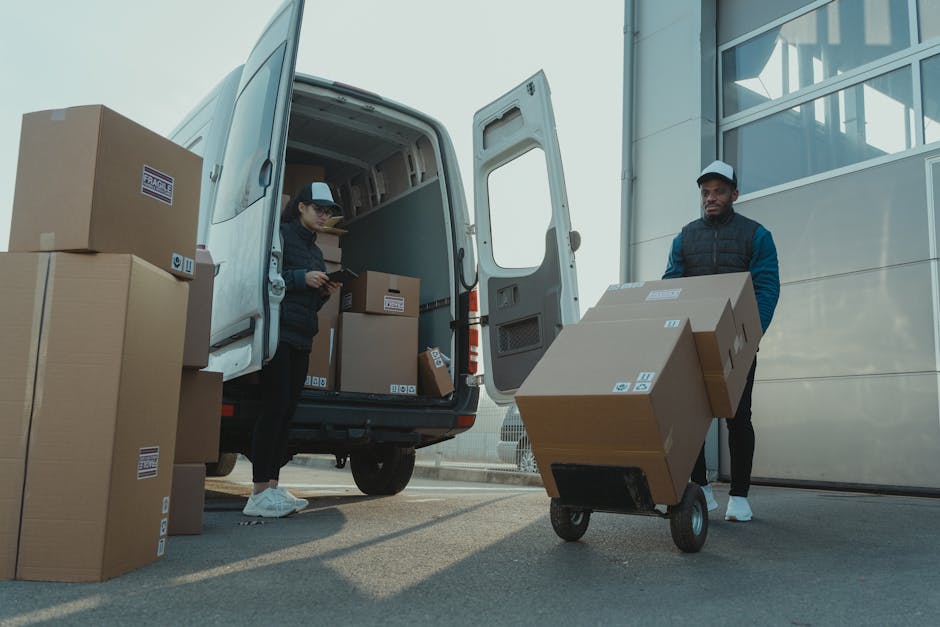Sustainable Warehousing: Balancing Efficiency With Environmental Responsibility
Just as you’re seeking ways to enhance your freedom and control within your business, sustainable warehousing emerges as a key player in empowering you to balance efficiency with environmental responsibility.
You’re in the driver’s seat, navigating through energy-saving practises, waste reduction strategies, and the use of sustainable materials.
By investing in eco-friendly warehouse design and green logistics, you’re not only streamlining operations but also fostering a healthier planet.
It’s about making choices that ensure your warehouse’s footprint is as light as the goods it stores and ships.
Embrace this approach, and you’ll find that sustainability and business success aren’t just compatible—they’re mutually reenforcing.
Key Takeaways
- Prioritise energy efficiency and integrate renewable energy sources like solar panels and wind turbines in warehousing operations to minimise environmental impact.
- Implement waste reduction strategies such as circular packaging with reusable containers and pallets, optimising inventory to accurately forecast demand, and reducing excess.
- Focus on sustainable materials management through responsible resource use, conducting Lifecycle Assessments (LCAs), opting for easily recyclable materials, and establishing partnerships with sustainable suppliers.
- Design eco-friendly warehouses by integrating natural lighting, retrofitting with skylights and solar tubes, implementing rainwater harvesting, and conserving water to demonstrate commitment to resourcefulness.
Energy Efficiency in Warehousing

While you focus on streamlining your warehouse operations, it’s crucial to prioritise energy efficiency to minimise environmental impact. Leveraging renewable sources is a strategic move that alines with your desire for operational autonomy and a reduced carbon footprint. Solar panels and wind turbines can serve as a testament to your commitment to sustainability, providing clean energy that powers your warehouse with less reliance on the grid.
You’ll also benefit from integrating smart lighting systems. These not only cut down on energy consumption but adapt to the natural light levels and occupancy of the space. It’s a savvy approach that doesn’t just lower your bills—it also reduces the strain on our planet’s resources. Equipped with motion sensors and time schedules, smart lighting ensures that you’re not wasting lumens in unoccupied zones, exemplifying a keen analytical mindset towards resource management.
As you refine your energy use, remember that it’s just one piece of the sustainability puzzle. Next, you’ll want to explore how to dovitalize your operations further. Waste reduction strategies represent the next frontier in your eco-conscious journey, offering a path to not only freedom from excess costs but also a lighter ecological footprint.
Waste Reduction Strategies

To further your warehouse’s sustainability, you’ll need to implement waste reduction strategies that not only cut costs but also kerb your environmental impact.
Circular packaging is a transformative approach that embodies the essence of sustainability. By adopting reusable containers and pallets, you’re not just minimising waste; you’re participating in a closed-loop system that continuously recirculates resources. This strategic shift positions you at the forefront of eco-conscious warehousing, where the freedom from traditional single-use packaging isn’t only liberating but also financially prudent.
Inventory optimisation is another critical facet of your waste reduction arsenal. By leveraging data analytics to accurately forecast demand, you ensure that you’re stocking what’s needed and nothing more. This precision curtails the excess that often leads to wastage. It’s a strategic move that alines your operational efficiency with environmental stewardship.
In essence, these strategies offer a dual benefit: they free your warehouse from the costly cycle of waste and empower you to contribute positively to the planet’s health. Embrace them as part of your core operations, and you’ll see that sustainability and profitability can coexist, driving your business towards a greener, more responsible future.
Sustainable Materials Management

Implement sustainable materials management in your warehouse operations to ensure resources are used responsibly and efficiently. Embracing this practise isn’t just about being eco-conscious; it’s a strategic move towards a circular economy, where materials are kept in use for as long as possible, extracting the maximum value from them while in use and recovering and regenerating products and materials at the end of each service life.
Consider the following steps to advance your sustainable materials management:
- Conduct a Lifecycle assessment (LCA) to understand the environmental impacts of the materials you use and identify areas for improvement.
- Opt for materials that can be easily recycled or repurposed at the end of their lifespan.
- Establish partnerships with suppliers who prioritise sustainability in their production and distribution processes.
- Implement inventory management systems that reduce overstocking and avoid waste.
By strategically managing materials, you’re not just cutting costs but also fostering a sense of freedom from wasteful practises. Your actions contribute to a healthier planet and a more resilient economy.
As you refine your approach to materials, let’s transition to exploring how eco-friendly warehouse design can further enhance your commitment to sustainability.
Eco-Friendly Warehouse Design

Beyond sustainable materials management, integrating eco-friendly design into your warehouse infrastructure is a key step towards reducing your environmental footprint.
Delving into the specifics, natural lighting is more than just a buzzword; it’s a strategic move to slash energy consumption and enhance worker wellbeing. By retrofitting your warehouse with skylights and solar tubes, you can harness daylight and significantly reduce the need for artificial lighting. This not only saves costs but also allows for autonomy from the grid and has a lighter ecological impact.
Another strategic approach is rainwater harvesting, which embodies the eco-conscious spirit by turning an abundant natural resource into an asset. By setting up a collection system on your warehouse roof, you can capture rainwater for non-potable uses such as irrigation or flushing toilets. This move not only conserves water but also demonstrates a commitment to resourcefulness and innovation.
Green Logistics and Transportation

As you explore sustainable warehousing, consider how a shift to green logistics and transportation can significantly lower your carbon footprint. In this pursuit, you’re not just optimising your operations; you’re contributing to a larger movement for environmental stewardship.
Embracing this change isn’t just about adhering to regulations or meeting customer expectations; it’s about asserting your freedom to choose a path that alines with your values and the well-being of the planet.
Here are four strategic steps to integrate into your logistics for a greener future:
-
Fleet Electrification: Transition your fleet to electric or hybrid vehicles to reduce emissions and reliance on fossil fuels.
-
Route Optimisation: Implement advanced planning systems to minimise travel distances and fuel consumption.
-
Carbon Offsetting: Invest in projects that compensate for your transportation emissions, effectively balancing your environmental impact.
-
Collaborative Distribution: Partner with other businesses to consolidate shipments, maximising load efficiency and reducing the number of trips needed.
Frequently Asked Questions
How Does Sustainable Warehousing Contribute to a Company’s Overall Corporate Social Responsibility (Csr) Goals?
You’ll enhance your CSR by implementing sustainable warehousing, strategically using green procurement and carbon accounting to reduce environmental impact, thus securing freedom from regulatory pressures and alining with eco-conscious consumer expectations.
What Are the Challenges and Potential Cost Implications of Transitioning to a Sustainable Warehousing Model?
You’ll face green retrofitting challenges and must conduct a cost-benefit analysis to ensure your freedom to operate alines with eco-strategic goals while navigating the financial implications of a sustainable warehouse transition.
Can Sustainable Warehousing Practises Improve Worker Health and Safety, and if So, How?
Yes, by implementing green lighting and ergonomic equipment, you’ll reduce strain and improve visibility, strategically enhancing both safety and well-being in your warehouse, alining with your eco-conscious values and desire for operational freedom.
How Do Customers Perceive Companies That Invest in Sustainable Warehousing, and Does It Affect Consumer Buying Behaviour?
You’ll find that green perception significantly sways buying trends; customers often favour companies with sustainable practises, seeing them as forward-thinking and responsible, which can drive your freedom to choose ethically.
What Are Some Innovative Technologies on the Horizon That Could Further Revolutionise Sustainable Warehousing Practises?
Imagine warehouses with green roofs, not just for show, but as energy-savvy hats. You’ll see energy analytics guiding decisions, a strategic dance of data and nature for that eco-conscious, freedom-craving crowd.
Conclusion
In the grand tapestry of global commerce, your warehouse can shine as a beacon of sustainability. By championing energy efficiency, slashing waste, and embracing eco-friendly materials and design, you’re not just storing goods—you’re safeguarding our planet.
Strategic green logistics transform transportation into an earth-friendly triumph. Remember, every small step you take is a giant leap for environmental stewardship.
Embrace this sustainable revolution in warehousing, and watch your efficiency soar as high as your ecological integrity.
Contact us to discuss our services now!
